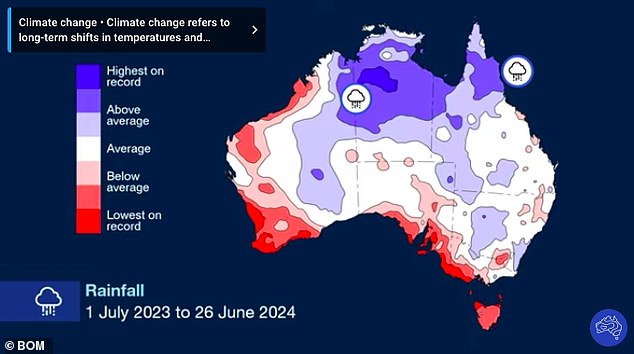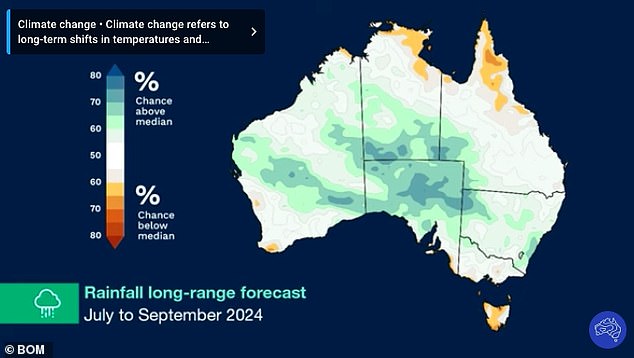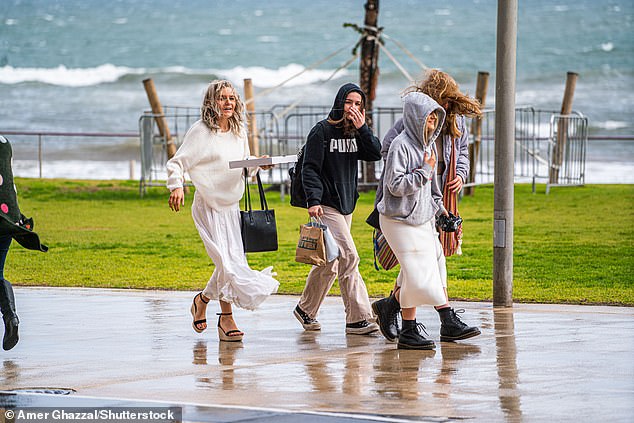Heavy rain forecast to inundate large parts of the country this week could mark the start of a wetter-than-average winter and spring for most Australians.
A massive band of rain stretching nearly 5,000 kilometres across the country will inundate areas south of Geraldton in Western Australia and Brisbane in Queensland.
Large pastoral areas across western Western Australia, South Australia and the Murray-Darling Basin (covering more than one million square kilometres in south-eastern Australia) are expected to receive up to 25mm of rainfall this week before the rain band moves eastwards.
Up to 50mm of rain is expected on Sunday and Monday across inland regions of eastern Australia, including northern New South Wales and southern Queensland.
Precipitation is expected to be above average for the area throughout the winter.
Meanwhile, another band of rain will sweep across Western Australia on Tuesday and Wednesday, bringing strong winds, rain and cold temperatures.
Up to 50mm of rain is expected within a 400km radius from Perth to Wapole.
The rain band will then move into south-east Australia, where widespread rainfall of up to 30 mm will inundate south-west Victoria and southern South Australia.
Heavy rain forecast to inundate large parts of the country this week could mark the start of a wetter than normal winter and spring for most Australians (pictured are people in Adelaide)
This comes after a long-range forecast from the Bureau of Meteorology revealed that above-average rainfall is likely across large parts of eastern and central Australia, including pastoral areas in South Australia and parts of the east coast, from July to September.
The forecast also predicts that rainfall is likely to be within the typical seasonal range for most of northern Australia, Western Australia and Victoria.
“Storms are still common in parts of southern Australia at this time of year, bringing a risk of flooding during times of heavy rainfall, especially in areas where the ground is already saturated,” said climate scientist Caitlin Minney.
Below-average rainfall is likely in July across western Tasmania and isolated areas in the far south-east of the mainland.
Warmer than average days are likely in northern, eastern and southern Australia, and warmer than average nights are likely across Australia.

Above average rainfall is expected across eastern and central Australia between July and September
“While cold fronts and other weather events may still bring cool conditions, the long-range forecast continues to show an increased likelihood of unusually high temperatures between July and September,” Minney said.
‘Across the country there is an increased likelihood of above-average temperatures.’
This week, a trough and cold front will bring icy winds and rain to the southwest coast of Western Australia through to the Pilbara.
The system is expected to cross over on Tuesday, bringing cool temperatures this week.
In Sydney, up to 10mm of rain on Tuesday is expected to clear by Wednesday, when temperatures will peak at 19°C.
Clouds will return on Thursday with the potential for showers on Saturday.
Brisbane is set to receive wet and wild weather at the start of the week before skies clear on Wednesday with temperatures set to peak at 25°C.

Rainfall will be typical across northern Australia, Western Australia and Victoria this spring.
In Darwin, skies will remain clear and blue with a high of 32°C this week.
Further south, the ACT is in for a cold and wet week filled with showers, icy winds, patches of frost and sub-zero temperatures.
In Hobart, heavy rainfall in western and eastern parts of the island state could exceed 50mm this week and temperatures will remain below 15°C.
Dry areas of southern South Australia will receive some light rainfall early in the week before a cold front and associated rain band delivers between 10mm and 30mm to the same areas towards the end of the week.
In Victoria, the same cold front will bring rain to western parts of the state and is expected to see Melbourne’s heaviest rainfall this week on Tuesday.
(tags to translate)dailymail

